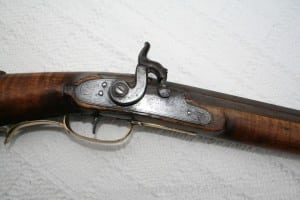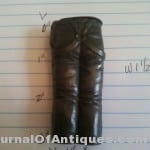The Civil War Collector – July 2013
By John Sexton

It is: a Kentucky Pennsylvania rifle, percussion cap, muzzle-loading rifle; curly maple stock; barrel is octagonal and 45.5-inches long; brass patch box and butt plate; stock has carving on opposite side of patch box (bird?); and engraving on stock plate (ducks and dog), on hammer, lock plate has name of “Josh C. Randle” with “Warranted: printed under the name. Any information would be appreciated and lend to the conversation as house guests admire it hanging over our fireplace.
In the early 19th century in rural America, you would have probably had a rifle in your home for hunting small game and protecting your property. If you didn’t have an old military musket, you probably had one of the tens of thousands of the only truly American rifle form seen here.
The most typical Kentucky rifle was just a utilitarian tool, no embellishment, just functionality. Your gun has some added decorative and functional features, such as the long three-piece, hinged, decorated patch box and the fancy striped maple stock with a bit of incised carving.
Unfortunately, this gun has been cleaned, and like a fine piece of furniture from this era, it loses a lot of its value. With “untouched,” great patina on wood and metal, this gun would sell for between $4,000 and $6,000 as is. Now, it will probably bring about half that figure, $2,000-$3,000. James D. Julia auction of Fairfield, Maine, has sold a great many high-quality rifles of this genre in their last couple of catalogs, which can be seen online to give anyone interested a better idea of what the best “Kentucky” rifles can bring.
Q: Dear Mr. Sexton: Found a metal pair of pants about three inches high. Remembered what my grandmother said about these, but you know how grandmothers can be. Her story is that during the Civil War, they used these holders to keep matches dry. I know on the inside top it says, “Patented Nov. 9, 1886”; however, maybe this item just wasn’t patented until then, but was still in use before that. What are your ideas on this?
Q: I have recently purchased a stretcher at a flee market, and the woman who sold it to me said it was Civil War Era, but I am not 100% sure. I believe it is a very unique piece, and it is in amazing condition. There are faint blood stains from top to bottom. The pillow connects to the legs and was filled with horse hair or straw. I just know that it truly is from long ago.
John Sexton is an independent appraiser and expert of Civil War memorabilia. He is an accredited member of various appraiser organizations. He can be contacted at 770-329-4984 or www.CivilWarDealer.com. If you have a Civil War item for him to appraise, email a photo and a description to mikemcl@midnspring.com.











Related posts: